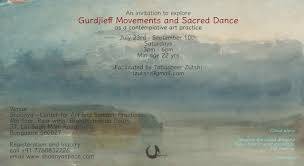Gurdjieff Movements & Sacred Dance

Details
Jul 23 2022 to Sep 10 2022 3 p.m.
EVENT HAS ENDED
Where
Shoonya - Centre for Art and Somatic Practices
4th Floor, Rear Wing, Brahmananda Court, 37, Lal Bagh Main Road 560027
Event Description
The Significance of the Body is its role as our sole instrument of expression & communication. Created by the Greek Armenian mystic G I Gurdjieff as practices in self-experiencing and awareness, the movements and sacred dances, along with a large body of music and seated contemplative exercises emerged as a distilled concentration of his teachings on human transformation and development. The movement's practice is considered a hologram of his unique oral and written body of knowledge. He held that millennia ago sacred dance was essentially a mode of communication, a universal language with its own grammar, vocabulary and semantic usage. Each dance was a book, each sequence or rhythm a phrase, each gesture or posture a word. The Movements, as originally intended, are a complex and sophisticated instrument which encode esoteric principles and knowledge of the nature of reality and the laws contained therein. Attention is essential energy in a human being. And this energy can only appear when one is constantly occupied with seeing, listening, and questioning. We must give our complete attention to the question in front of us. The attention will not be total if we seek an answer. Total attention is the process of meditation. To see requires attention that is active, not simply one produced by the shock of an outer impression. We need to realize that our usual attention is not in contact with what it perceives, and as a result, we do not really see. For this contact, the attention must become active. To be present requires dividing the attention. At the outset, the Gurdjieff Movements are a practice of attention with specially composed music for each dance. The Movements demand great effort and sustained attention as participants are required to coordinate complicated head, arm and leg movements with mental exercises, all the while maintaining a sense of presence and awareness. They are a means of self-study and a catalyst for inner growth. We move through life in patterns that remain unconscious akin to a state of sleepwalking. The Movements break up those patterns, bringing awareness to habitual behaviour of interacting with ourselves and the world. Working in a group is essential to the practice as here we are brought in relation to the ‘other’, and here lies the possibility of awakening to our presence and actions in the world. In time as the movements begin to integrate with awareness, the body relaxes and the mind stills. Here we begin to awaken to another possibility of understanding and view. The movements are beautiful but not aimed at an aesthetic or performative display, rather they are stripped bare of embellishment and ornamentation to an essential symbolic form. This suggests its departure from ‘self-expression’. They are a practice to deepen our chosen paths of seeking meaning. An exacting enquiry and struggle are needed. The work is a serious undertaking meant for those willing to make the required efforts. It is neither therapy, nor a means to alleviate psychological conflicts, although in time the movement may bring about a quiet stillness, a spacious interiority, and a more harmonious inner togetherness. The eight sessions will mobilize an in-depth exploration of this dynamic discipline. The methodology of studying and embodying the dance is woven intricately with contemplative exercises, conversations and playful experimentation. Although the movement work groups are open to all, they are in particular aimed at those that want to deepen their own contemplative practices and processes. About the facilitator: Tabasheer has been teaching the Gurdjieff Movements for the past eight years to a disparate community from various parts of the country. Her encounter with Gurdjieff’s teachings and practices nearly two decades ago sparked a deep study into the body of work and its methodology. Her (late) teacher Akash Dharmaraj, a practising clinical psychologist was exceptionally gifted in artfully blending her knowledge of psychotherapy and the Fourth Way ideas, with The Movements. A decade later she met mathematician, physicist and philosopher A.G.E. Blake who had been mentored by Gurdjieff’s direct student J.G. Bennett. He influenced her explorations from the perspective of myth and storytelling (which are deeply embedded in Gurdjieff’s writings), symbolism, cosmology (through the lens of philosophy and physics), dialogue, theatre, and transformational art of deep listening. She uses the lens of contemporary life, constantly enriching her facilitation with new research to expand, shift perspective and remain authentic to the present. Her influences have been shaped by mentors from the direct lineage of Gurdjieff, study and practice of Iyengar school of yoga, art, and gardening. Born in Bombay in 1975, Tabasheer Zutshi graduated in Ancient Indian Culture from St. Xavier’s College, Bombay and later studied painting at The Delhi College of Art. Professionally, she has been a production and costume designer. Her work extends to film, theatre, installation, performance and sound art. Her artist collaborations as a costume designer and art director have been part of various art and theatre festivals. She has been living in Bangalore for the past seven years. The classes will proceed over eight sessions, every Saturday, 3 pm to 6 pm, beginning 23rd July to 10th September.
Upcoming events in Shoonya - Centre for Art and Somatic Practices
We don't have any upcoming events listed for this venue.
(Venue owners / event managers, to get your event listed, reach out to us.)